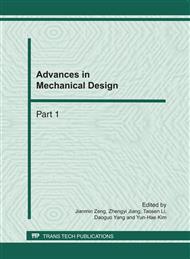p.784
p.790
p.796
p.801
p.805
p.811
p.819
p.824
p.831
Analysis and Design of Stator of Traveling Wave Type Rotary Ultrasonic Motor
Abstract:
Due to its compact sizing, fast response and good control performance traveling wave type rotary ultrasonic motor (TRUM) has significant potentials for applications in robot actuation. In order to considering the complex geometries, this paper presents modeling approach for micro-TRUM stator. First piezoelectric composite stator is partitioned into three substructures, two of which are modeled as several continuous annular plates by semi-analytical method. Without losing the complex geometries, the stator teeth as another substructure are modeled by means of finite element (FE) approach. Based on both component-mode synthesis and dynamic reduction, the coupled method for continuous plate and FE discretized teeth is presented in order to consider dynamic behavior of composite stator with good accuracy and short computation time. It allows combination of the continuous parameters and FE discretized substructures, and the mathematical model representing the complete stator is derived. Finally the prototype is manufactured according to the presented method. The validation of the analysis and design method is attained through the experiments for the manufactured stator. It is pointed that radial friction can be capable to increase s for the ultrasonic motor with smaller dimension. It explains why micro-TRUM has a fast heat output at the contact interface.
Info:
Periodical:
Pages:
805-810
Citation:
Online since:
February 2011
Authors:
Price:
Сopyright:
© 2011 Trans Tech Publications Ltd. All Rights Reserved
Share:
Citation:


